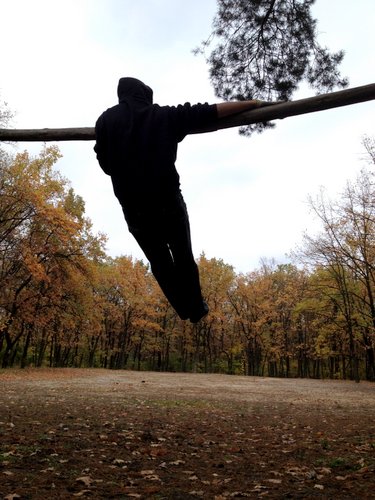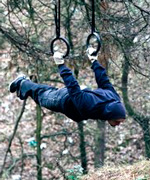11 Ways to Use Your Environment in Strength Training
By Alex Zinchenko
I don’t know what the situation is in your country, but here in Ukraine the vast majority of people still believe that they can’t reach their fitness goals without going to a commercial gym. People honestly assume that the more exercise machines the gym has—and most importantly, how shiny they are—the faster their body fat will melt off. They prefer walking/running on treadmills and pedaling fake bikes in crowded "cardio areas" instead of enjoying the fresh air and amazing scenery if they were doing the same things outdoors. In my opinion, it’s not right!
The world we live in is an amazing, fascinating place—it already has the whole gamut of tools to help us with our strength quest. We can divide all the available implements into two distinct categories:
- Items that help us use our own bodyweight as resistance
- Items we can use as resistance (lift)
Here’s how we can use the environment in our strength training according to these categories.
Bodyweight as Resistance
1. A Pull-Up Bar and Alternatives
A pull-up bar is easily one of the most versatile training implements. You can perform a myriad of exercises with it—
pull-ups, front levers, back levers, muscle-ups, dips, even planches and handstands.
You might ask what you can do if you don’t have a pull-up bar. Take a look around, a sturdy tree branch or pipe will do just as well, if not better. The type of stairs that allow you to hang from the underside will work too. Just imagine how cool will you look banging out chin-ups on a rusty two-inch pipe!
To add some more variety and challenge, you can use towels or ropes. Your hands will beg for mercy but will develop a vice-like grip!
Finally, if there are no pull-up bars, trees, or pipes around, do not get frustrated. Find two equal and robust objects that are high enough, like two doors. Put a two-inch pipe on top and you will have a DIY pull-up bar. Yes, it is dangerous and you will need to put something under the doors to prevent them from breaking, but it works.
"Can’t you do pull-ups on the door itself?" Yes, but in this case, you are limited just to pull-ups, and no one-arm work or front levers, etc.

2. A Backpack
Once certain bodyweight resistance exercises become too easy for your herculean body, you can make them harder by adding weight with a simple backpack. Put something heavy inside and you’re all set. Apart from the obvious—making exercises more challenging—I found a backpack is particularly useful for smoother transitions between
advanced bodyweight progressions like the planche and front lever.
Alternatively, you can use an army-style duffel bag, it’s harder to attach to your body, but you will have the opportunity to go heavier.
3. Dip Bars and Alternatives
Dip bars are another type of training apparatus that brings joy and effectiveness into your bodyweight strength training sessions. They are somewhat less versatile than the pull-up bar, but still worth mentioning.
In case you don’t have dip bars around, two objects of equal height will work. When I was traveling, I used a corner of the balcony rail.
Please note if you are doing weighted dips with flat palms, point your fingers a bit to the side so you won’t feel discomfort in your wrists.
4. Rings
Technically, rings are not part of the "environment", but I think it is important to mention that rings are probably the best portable training implement for your upper body that you can use almost anywhere.
5. The Pulley System
This is not something in the "environment" either, but is so easy to apply and effective, that I must include it. I learned about this system from Jack Arnow. All you need is a pull-up bar, one or two pulleys, a cable, two strong hooks, and some weights:
A. Attach pulleys to the bar
B. Pull the cable through them
C. Attach hooks to the sides of the cable, one for the counterweight, the other one will be attached to you with a belt.
That’s it! Of course, it is not very convenient, but the system’s potential is tremendous. Just imagine performing a full planche, a one-arm chin-up, or the front lever right now—it will be possible with this pulley system.
It’s obvious, but do not forget that you can always train
push-ups and planches instead of bench presses, and handstand push-ups instead of military presses, etc.
What to Lift?
7. Sand
Sand is the most effective item in the environment you can lift. I am not talking about a cheesy music video scene with an actor on his knees lifting two handfuls of sand in the air for an epic pose. I am talking about heavy old-school sandbag strength training.
How does it work? Take any heavy-duty bag, stuff sand inside, lace it, and lift. You can do almost any barbell exercise with a sandbag—military presses, bent-over rows, squats, cleans, etc.—everything is possible.
Additionally, sandbag strength training has some pleasant bonuses as compared to other training tools:
- Your hands and fingers will feel the difference. Grabbing a sandbag is a workout inside a workout. The rest of your body will notice sandbag work too. Prepare for soreness in places you never thought existed!
- Sandbags have an ever-changing center of mass, so they are harder to lift and stabilize.
- Sandbags have amazing potential for progression. You can add as much sand inside—from a fistful up to 10, 20 or even 50 kg. - You can perform unique exercises with a sandbag like platform loads or shouldering.
- Sandbags are perfectly safe, even if you drop one on yourself.
Sandbag strength training is ultra-simple, ultra-versatile, and ultra-effective. If you don’t use it, you are missing out.
8. Stones
If you are lazy and do not want to bother with making a sandbag, you can use a stone. It is less safe, but it can help you to gain strength and build muscle too. And you can usually find one in 10 minutes or less.
I wouldn’t do floor presses with a stone, but everything else is possible.
9. Wood
Don’t forget you can use wood too. Watch Sly in
Rocky IV or Arnold at the beginning of
Commando—those movies should give you some ideas!
10. Cars
Yes, those metal machines can be used for strength training too. You can push, pull, and deadlift them. Please remember to let the owner of the car know what you are going to do!
11. Any Other Generally Useless Heavy Objects
Use anything you can lift. It is that simple.
How Does It Work?
It all works because of resistance. Your body cannot differentiate whether the resistance is coming from a barbell or any other heavy object, including your own body. That’s why
calisthenics,
kettlebells and any other object will work.
What to Remember?
It may seem like all you need to do is just run around and spontaneously lift heavy objects here and there in an unstoppable berserker fashion, but that’s not correct. To get stronger, you still need to apply the princigple of progressive overload, no matter what training implement you are using. Getting results will require proper programming. It may be harder to do this with unconventional objects, since they are much less scalable for intensity. However, do not get discouraged because intensity is just one variable in the equation. You still have training volume and frequency to manipulate.
In other words:
- You still need to get stronger or improve in some way with every training session. For example, if you can press a 60 kg stone for 3 repetitions today, then you should strive for at least 4 reps in 5-7 days.
- If the weight of most of your training implements is fixed (including your bodyweight), then find ways around it. For example, progress in repetitions, time under tension, sets, decreased rest times, or more difficult exercises, etc.
- All the principles of effective strength training apply to unconventional objects too. You wouldn’t perform a heavy bench press every day, right? Pressing a heavy stone every day isn’t a good idea either.
Putting It All Together
Theory without practice is dead, so here is an example of a training routine you can perform with everyday objects.
Day 1
A) Sandbag Military Presses – 3 sets x 5 reps
B) Weighted Chin-Ups – 3 x 5
C) Diamond Push-Ups – 4 x 8
D) Towel Pull-Ups – 4 x 8
Day 2
A) Pistols – 3 x 5
B) Car Deadlifts – 3 x 3
C) Stone Curls – 3 x 10
D) One-Leg Calf Raises – 3 x 15
Day 3 – Off.
Day 4
A) Handstand Push-Ups – 3 sets of 6
B) Front Lever Raises – 3 sets of 6
C) Dips – 4 x 8
D) Sandbag Bent-Over Rows – 4 sets of 8
Day 5
A) Car Pushing – 3 x maximum
B) Sandbag One-Arm Swings – 3 sets of 5 per arm
C) Back Bridge – 3 x max hold
D) Bodyweight Triceps Extensions – 3 x 10
Days 6 and 7 – Off.
Of course, this is just an example routine. Since I don’t know your goals, if you want to use this routine, you will need to tailor it to your current goals and conditions.
Closing Thoughts
By now, you should have learned a thing or two and most importantly, should have a couple of ideas on how to implement them in your own training. Remember, you do not need a gym to achieve results. The world is your gym. Thanks for reading.
Play rough!
Alex Zinchenko
P.S. In case I forgot any cool way to use environment in strength training, I would gladly discuss it in comments.
 Alex Zinchenko is a strength addict, coach and the author of the Rough Strength blog, where he shares his crazy ideas regarding training and nutrition. He is honest to toothache, straightforward like a train, and too daring to believe that heavy calisthenics, kettlebell and sandbag training along with intermittent fasting can deliver all the results you want.
Alex Zinchenko is a strength addict, coach and the author of the Rough Strength blog, where he shares his crazy ideas regarding training and nutrition. He is honest to toothache, straightforward like a train, and too daring to believe that heavy calisthenics, kettlebell and sandbag training along with intermittent fasting can deliver all the results you want.
If you are interested in the Rough Strength Method, you can check out his book "Rough Strength Files: 42 Ideas on Low-Tech Strength Training" here and here.
Back